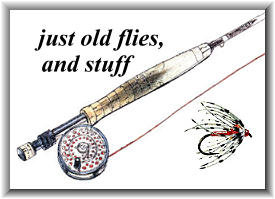Fly patterns that make a splash usually see their
popularity evaporating within a decade, and by the
two-decade mark drift only as foggy memories in the
backs of most fly fisher's minds. A few, however,
endure. The Bomber is among those few.
After thirty to forty years on the scene, this fly still
shows up in the catalogs of some big fly-fishing mail-order
houses, and those businesses carry only what sells. Clearly
the Bomber, after all these years, still sells.
The Bomber first appeared, according to Joseph Bates, Jr. in
his book Atlantic Salmon Flies & Fishing, in
1967 for use on New Brunswick's Miramichi River. "Though
designed for Atlantic salmon, the fly then," says Kent Helvie
in his book Steelhead Fly Tying Guide, "made its way west
and the steelhead fishermen grabbed it up." The Book
of Fly Patterns by Eric Leiser, published in 1987,
describes the Bomber as "one of the most popular salmon dry
flies used in Canada."
Bates says that the Bomber is fished "dry, dry and dragging
(with a fast skittering motion), or wet with a sinking line."
I doubt many Bombers are thrown on sinking lines today, but
"dry" and "dry and dragging" are probably as common as ever
for Atlantic salmon, and for steelhead.
Then there's the Green Machine, another child of the Miramichi
River. Though similar in form to the Bomber—a fat trimmed-hair
body with a single hackle spiraled up it—the Green Machine is
commonly fished subsurface. It is a member of the Wet Bug line
of salmon flies and as Dick Talleur explains in his book
The Versatile Fly Tyer, it appears "at first glance to
be a dry fly, and it probably could serve as such, but that's
not usually how it's fished." He goes on to say that the Wet
Bug series is most effective fished "just beneath the surface
or in the film."
Yet even if the Bomber and Green Machine are usually fished
differently, they have much in common—both were born on the
Miramichi, both were designed for Atlantic salmon, both possess
plump bodies of flared-and-shaped deer hair bristling with
hackle fibers, and both are tied in about the same manner.
And, where one has endured, the other promises equal longevity.
Bomber:
Hook: Slightly heavy to medium wire, up or down eye.
4X long, sizes 8 to 2.
Thread: Brown or tan 8/0 or 6/0 for the tail, hackle,
and wing. Size-A rod-thread for flaring the deer-hair body.
Tail: Woodchuck guard hair (or substitute calf tail,
squirrel tail - any fairly stiff hair.)
Hackle: One, brown (though I like to bind on two, one
as a back-up.)
Wing: The same hair as you used in the tail.
Body: Natural deer hair. (All sorts of dyed hair
colors - sometimes in contrasting bands - are commonly used.)
Green Machine:
Hook: Slightly heavy to medium wire, sizes 8 to 4.
Thread: Green 8/0 or 6/0 for the tip, tag, and hackle.
Size-A rod-thread for body.
Tip: Fine silver Mylar tinsel.
Hackle: One, brown (I bind on two, for insurance).
Body: Medium-green deer hair.
Credits: Morris On Tying Flies
by Skip Morris, published by Frank Amato Publications.
~ DLB
|



